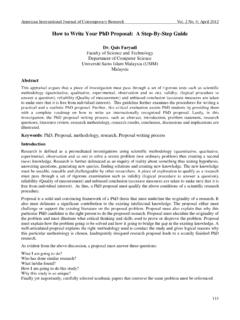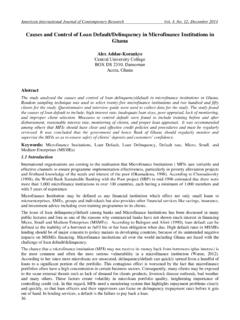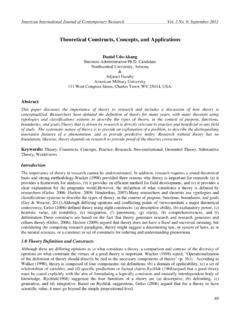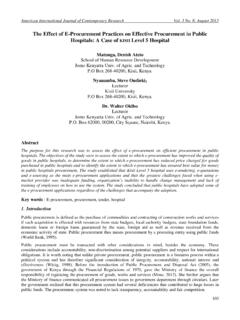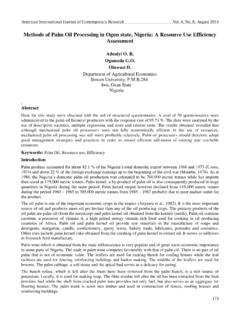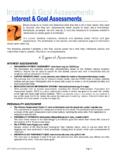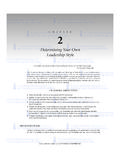Transcription of Leadership Analysis Using Management Tools: …
1 American International Journal of Contemporary Research Vol. 4 No. 2; February 2014 125 Leadership Analysis Using Management Tools: steve Jobs Vadim Kutsar, Nabarun Ghose, Yuriy Kutsar College of Business The University of Findlay 1. Introduction Many great leaders have led companies to growth and prosperity in various ways with different styles. In the technology sector, steve Jobs is one of the most celebrated leaders. Steven Levy stated that steve Jobs was the most passionate leader one could hope for, a motivating force without parallel (Markoff, 2011). His Leadership , defined by his personality and traits, could be observed and evaluated from the perspective of several models and theories.
2 Table A1, in Appendix A, lists several assessment tools that define steve Jobs s Leadership . Jobs s Leadership characteristics are especially evident, as he came back to Apple in 1996, when the company was in dire straits. He said that if Apple did not get the attention it needed, it could eventually die (Kahney, 2008, p 1). Currently, because of the Leadership of Jobs, Apple is one of the leaders of innovations in the technology sector and one of the most esteemed brands (Myatt, 2013). Jobs has played an active role that has shaped Apple into the technology giant that it is today. 2. Background When studying a leader it is important to look into his or her upbringing, as this may greatly influence future decisions, personality, and traits.
3 steve Jobs was born in San Francisco, in 1955, to undergraduate parents, whom were unable to care for him and, consequently, put him up for adoption (Kahney, 2008, p 5). The Jobs family adopted and raised him in Mountain View, California, where steve Jobs initially fell in love with assembling electronics, particularly TVs (Kahney, 2008, p 5). Jobs attended Reed College but, quickly becoming bored, dropped out and continued to unofficially take a few courses that had interested him, such as calligraphy (Kahney, 2008, p 6). Not long afterwards, Jobs acquired a job at Atari and, when obtaining enough money, set off on a trip to India in search of enlightenment (Kahney, 2008, p 6). Upon returning to California, Jobs met steve Wozniak and together created Apple at Jobs s parents house (Kahney, 2008, p 6).
4 Apple immediately took off and, within a few short years, Jobs was a multimillionaire. Not long after, in 1985, Jobs left Apple secondary to a power struggle with then CEO John Sculley (Kahney, 2008, p 7). Jobs subsequently founded NeXT, a software company, and acquired Pixar, which became widely successful (Kahney, 2008, p 8). And, after 11 years away from Apple, he returned as interim CEO, in 1996 (Kahney, 2008, p 8). Jobs acquired a foothold back at Apple because it was in financial trouble, on the brink of bankruptcy. Then CEO, Gil Amelio, was looking for a new operating system to try and revamp Apple. This was a shining opportunity for Jobs to pitch his NeXT company. After speaking with Jobs, Amelio thought that this would be a step in the right direction for Apple, and acquired the company for $427 million, reintroducing himself back at Apple (Kahney, 2008, p 19).
5 Right before Jobs arrived, Apple was six months away from bankruptcy, and the turnaround that Jobs was able to achieve, while at Apple, is known as one of the greatest comebacks in business history (Kahney, 2008, p 8). 3. Leadership Assessment Myers-Briggs Type Indicator There are many ways to study a leader, including various models, theories, tests, and principles that can be applied when trying to understand Leadership . One of these tests, Myers-Briggs Type Indicator (MBTI), measures how individuals differ in gathering and evaluating information for solving problems and making decisions (Daft, 2001, p 119). When assessed by the Myers-Briggs Type Indicator (MBTI), steve Jobs would most likely be an ENTJ type, which is a person known to possess qualities such as vision, planning, taking charge, speaking heartily, and having qualities ofa natural leader (Daft, 2011, p 124).
6 Center for Promoting Ideas, USA 126 Vision is a picture of an ambitious desirable future for the organization or team (Daft, 2011, p 15). His vision is noted when he would come up with ideas and eventually see them through. Jobs once said that he had vision and to achieve it, he had no problem starting from the beginning by tearing down walls, building bridges, and lighting fires (Kahney, 2008, p 15). It was with this vision that he noticed Apple s tremendous assets and, when garnered with the right means, helped shape the company to what it is today. Jobs s meticulous planning also corresponds with the ENTJ-type person. When Jobs came back to Apple in 1996 as interim CEO, he spent weeks evaluating Apple s assets and holding meetings, with the intention of determining which products to keep or which products to get rid of (Kahney, 2008, p 25).
7 Every product was surveyed and every department head was interviewed, to determine what was essential and what could be withdrawn from the product line. This type of planning was never halted and continued throughout his time at Apple. Taking charge, another characteristic exhibited by the ENTJ-type person, is also observable in Jobs. While reorganizing Apple, he replaced most of Apple s board, re-managed the suppliers, and radically simplified Apple s product-line, from 50 to 10 (Khaney, 2011, pp 26-31). This ability to take charge turned out to be one of the most defining characteristics that Jobs possessed, eventually saving Apple from bankruptcy. A former Apple chairman had told Business Week that his jaws had dropped when he heard this news about restructuring, but it had turned out to be brilliant (Khaney, 2011, p 29).
8 Jobs s ability to drastically change Apple s Management and product line depicts his adept independent thinking. This type of thought process resulted in the simplification of Apple products to only four computer systems, which resulted in vast success. One of these computers, the iMac, a fruity-colored machine, became one of the best-selling computer of all time (Khaney, 2011, p 36). Fiedler s Contingency Model According to Fiedler s Contingency Model, Jobs would be classified as a task-oriented leader. Fiedler s Contingency Model was designed to enable leaders to diagnose both Leadership style and organizational situations (Daft, 2011, p 69). Task structure, the way tasks are defined, involve specific procedures with specific goals (Daft, 2011, p 70).
9 Jobs focused on a small selection of products and made sure the organizational chart was straightforward and streamlined, allowing goals and tasks to be met more efficiently and effectively (Khaney, 2008, pp 35-37). Alternatively, Jobs was not strongly viewed as a relationship-oriented leader, focusing on increased performance on the basis of human relationships. When Jobs took over, a new term was coined by employees, which was knon as Steved (Khaney, 2008, p 33). Some stories circulated that Jobs would quiz employees and, if the answers were unsatisfactory, they would be, Steved, that is fired on the spot; this occurred in various locations such as elevators (Khaney, 2008, p 33).
10 There are a few other quotes by Jobs that suggest his low-relationship status with employees, such as Well, you re a bunch of idiots when discussing the Mac operating systems to the lead designers and This is the first evidence of three-digit intelligence at Apple I ve seen yet when presented with a new interface for the Mac OS X (Khaney, 2008, pp 49-50). These as a basis, and other similar situational events, classify Jobs as a more of a task-oriented leader, rather than relationship-oriented. Although Jobs s relationships were often not pleasant, striking deals was one of his fortes. This ability depicts Jobs as a task-oriented leader, as it is used as a means to achieve specific goals.
